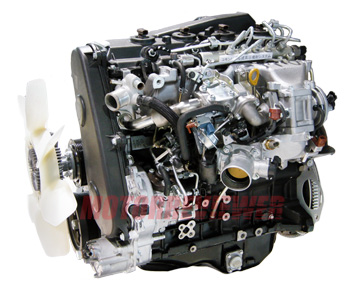Toyota 2KD-FTV Engine (2.5 D-4D) Specs, Problems & Reliability

Toyota's 2KD-FTV engine, also known as 2.5 D-4D, is a 2.5-liter inline four-cylinder turbo diesel engine. The engine has been produced since 2001 at a Japanese Toyota's plant and is installed in the Toyota Fortuner and 4Runner SUVs, Hilux pickups, and Innova, Hiace minivans. Toyota's 2.5L diesel engine is a member of the KD series, which included a 3.0-liter version - 1KD-FTV, but the 2KD is more related to the previous 2L engine.
The engine has a reliable cast iron, deep-skirt cylinder block, a crankshaft with eight balance weights and five journals, high-strength connecting rods, and aluminum pistons with Ni-resist cast iron ring carriers. At the bottom of the engine block, there are piston cooling oil jets, sprayed oil into the internal cooling channels of the pistons. Like the 1KD, the 2KD-FTV has an aluminum alloy 16-valve cylinder head. There is a steel-laminate type head gasket between cylinder head and cylinder block. On top of the engine, there are double overhead camshafts. The 2KD uses a rubber timing belt, which drives the intake camshaft only, while the exhaust camshaft is driven via a gear on the intake camshaft. Each cylinder has two intake and two exhaust valves. The valvetrain uses solid valve lifters (no hydraulic lifters).
Like the 1KD, the 2KD-FTV is equipped with Toyota's D-4D common-rail direct injection system. Instead of a variable geometry turbocharger, there is a turbocharger with mechanical wastegate valve (2KD-FTV in Thailand comes with VNT turbochargers - Variable-Nozzle Turbine). The more powerful 2KD-FTV engines have an air-to-air type intercooler mounted on top of the engine. The high-pressure fuel pump produces pressure ranged from 30 to 135 MPa for a regular engine version and up to 160 MPa - for the 2KD-FTV High Version.
In 2005, the engine went through some changes. It features the 3rd generation of Common Rail System (CRS) produced by Denso Corporation. The new injection system provides ultra-high injection pressure up to 200 MPa (29,000 psi). The compression ratio was reduced to 17.4:1. To complain of Euro 3+ emissions standards, the engine was equipped with cooled EGR (exhaust gas recirculation).
The 2KD-FTV is leaving in the past. Toyota already almost replaced the KD series in production by the new GD diesel family. This 2.5L turbo diesel gave way for a 2.4-liter 2GD-FTV engine.
Engine Specs
17.4:1 - 2005+
2KD-FTV Engine Problems and Reliability
The 2KD diesel engine can hardly be called super reliable. The list of issues very similar to the 1KD has. Until 2011, there was a problem with piston cracking. The piston oil rings are prone to stick and then cause high oil consumption. It is necessary to adjust the valve clearances regularly. Otherwise, the engine will have floating/unstable idling and loss of power. Many owners also complain about its too noisy operation and strong vibrations. The 2KD-FTV prefers a good fuel, low-quality diesel fuel kills the injectors very fast (by less than 50k miles).
In general, the engine does not have any significant drawbacks compared to gasoline opponents in this power range. An approximal engine life of Toyota's 2.5 D-4D is about 250,000 miles (400,000 km).
